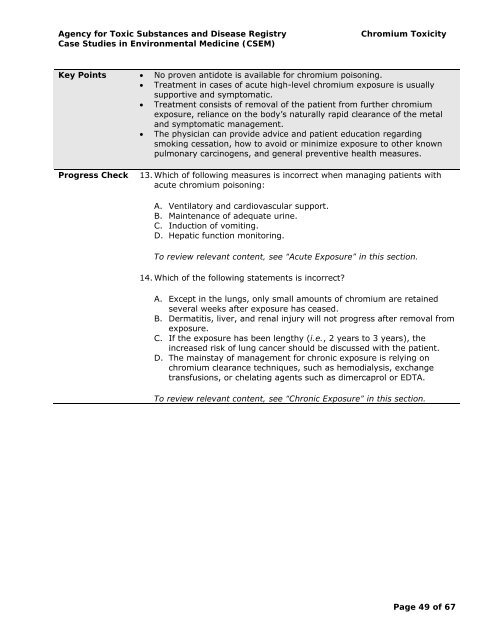(Cr) Toxicity | ATSDR - CSEM - Agency for Toxic Substances and ...
(Cr) Toxicity | ATSDR - CSEM - Agency for Toxic Substances and ...
(Cr) Toxicity | ATSDR - CSEM - Agency for Toxic Substances and ...
You also want an ePaper? Increase the reach of your titles
YUMPU automatically turns print PDFs into web optimized ePapers that Google loves.
<strong>Agency</strong> <strong>for</strong> <strong>Toxic</strong> <strong>Substances</strong> <strong>and</strong> Disease Registry Chromium <strong><strong>Toxic</strong>ity</strong><br />
Case Studies in Environmental Medicine (<strong>CSEM</strong>)<br />
Key Points • No proven antidote is available <strong>for</strong> chromium poisoning.<br />
• Treatment in cases of acute high-level chromium exposure is usually<br />
supportive <strong>and</strong> symptomatic.<br />
• Treatment consists of removal of the patient from further chromium<br />
exposure, reliance on the body’s naturally rapid clearance of the metal<br />
<strong>and</strong> symptomatic management.<br />
• The physician can provide advice <strong>and</strong> patient education regarding<br />
smoking cessation, how to avoid or minimize exposure to other known<br />
pulmonary carcinogens, <strong>and</strong> general preventive health measures.<br />
Progress Check<br />
13. Which of following measures is incorrect when managing patients with<br />
acute chromium poisoning:<br />
A. Ventilatory <strong>and</strong> cardiovascular support.<br />
B. Maintenance of adequate urine.<br />
C. Induction of vomiting.<br />
D. Hepatic function monitoring.<br />
To review relevant content, see “Acute Exposure” in this section.<br />
14. Which of the following statements is incorrect?<br />
A. Except in the lungs, only small amounts of chromium are retained<br />
several weeks after exposure has ceased.<br />
B. Dermatitis, liver, <strong>and</strong> renal injury will not progress after removal from<br />
exposure.<br />
C. If the exposure has been lengthy (i.e., 2 years to 3 years), the<br />
increased risk of lung cancer should be discussed with the patient.<br />
D. The mainstay of management <strong>for</strong> chronic exposure is relying on<br />
chromium clearance techniques, such as hemodialysis, exchange<br />
transfusions, or chelating agents such as dimercaprol or EDTA.<br />
To review relevant content, see “Chronic Exposure” in this section.<br />
Page 49 of 67

















